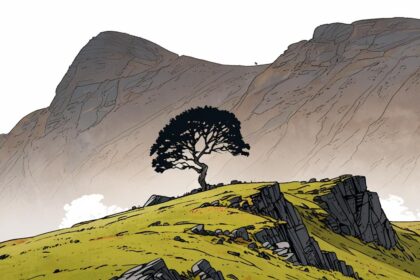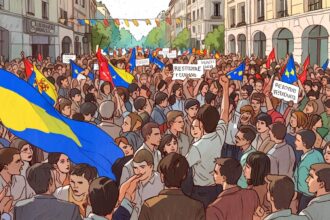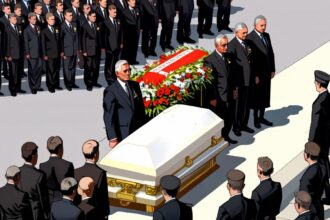On 25 June 2024, Kenyan security personnel opened fire on unarmed demonstrators opposing a controversial finance bill, resulting in multiple deaths and injuries. An extensive BBC investigation has identified those responsible and revealed eyewitness and video evidence exposing the lethal crackdown during protests outside Nairobi’s parliament.
On 25 June 2024, security forces in Kenya opened fire on unarmed protesters who had gathered outside the country’s parliament in Nairobi to oppose a controversial government finance bill, resulting in multiple deaths and injuries. The BBC has conducted an extensive investigation identifying key individuals among the security personnel responsible for the shootings, revealing critical details about the events and aftermath.
Young demonstrators, predominantly from the so-called Generation Z, had mobilised early that morning in the capital, creating an atmosphere described by human rights activist Boniface Mwangi as “a carnival.” The protests, part of a sustained movement against a government plan to increase taxes, had already compelled lawmakers to withdraw some proposed levies on essential items such as bread and cooking oil. However, other elements of the Finance Bill 2024, including increased import taxes and charges on specialised hospitals, remained contentious and were driving public dissent.
By 09:30 local time, thousands had converged from multiple directions, aiming to challenge the final parliamentary vote on the bill. Inside the chamber, Members of Parliament (MPs) commenced proceedings while outside, protests escalated in size and intensity. Initially, security forces employed tear gas, batons, water cannons, and rubber bullets to contain the crowds, but resistance grew, with demonstrators pushing police lines back significantly by early afternoon.
The Finance Bill was passed by a vote of 195 to 106 at 14:14, sparking outrage among the protesters. Within minutes, a police blockade was breached, and demonstrators made brief incursions onto parliamentary grounds, setting fire to an abandoned police truck and dismantling fences. Parliamentary security promptly dispelled the crowd, but the situation intensified.
BBC analysis identified a plain-clothes police officer, later named as John Kaboi, based at the Central Nairobi Police Station, who was heard on video shouting the Swahili word “uaa!” meaning “kill,” immediately before opening fire. Fatal shots were fired, killing two men: David Chege, a 39-year-old software engineer and Sunday-school teacher, and Ericsson Mutisya, a 25-year-old butcher. Five others were wounded in the incident, including one left paralysed. According to the BBC’s findings, none of those killed or wounded were armed or posed a threat at the time.
The protest did not dissipate following the shootings. At 14:57, demonstrators forced their way back into parliament, with video footage capturing their advance accompanied by placards and national flags. Despite warning shots, they entered, causing damage to the complex and prompting MPs to flee. Shortly after, at 15:04, further shots rang out as protesters exited, leaving three individuals lying on the ground. Among them was 27-year-old Eric Shieni, a finance student who was shot from behind in the head at close range. The BBC’s detailed image analysis identified a soldier firing the fatal shot from approximately 25 metres away; however, his identity remains unknown. Shieni was also unarmed.
The Kenya Defence Forces stated they had received no formal investigation requests regarding their personnel involved and affirmed their commitment to operating within constitutional mandates. The incident has prompted calls from legal experts such as Faith Odhiambo, president of the Law Society of Kenya, who remarked to the BBC, “The aim was to kill those protesters. They could have had him arrested. But the fact that you shoot his head—it was clearly an intention to kill.”
Following the week-long protests, Kenya’s National Commission on Human Rights reported a total of 39 deaths and 361 injuries nationwide. President William Ruto publicly thanked security forces for defending national sovereignty against what he termed “organised criminals” hijacking the demonstrations. Nonetheless, the following day, the president announced he would not sign the Finance Bill into law, stating, “Listening keenly to the people of Kenya, who have said loudly that they want nothing to do with this Finance Bill 2024, I concede.”
Despite the public outcry and parliamentary committee directives for an independent investigation by Kenya’s Independent Policing Oversight Authority (IPOA), no formal report on the events at parliament has been released, and no member of the security forces has been held accountable for the killings to date. The BBC’s Africa Eye report offers a comprehensive chronology of the protest and provides clear evidence implicating specific security personnel in the fatal shootings during the June 2024 anti-tax demonstrations outside Kenya’s parliament.
Source: Noah Wire Services
- https://en.wikipedia.org/wiki/2024_storming_of_the_Kenyan_Parliament – This resource supports the claim that thousands of protesters stormed the Kenyan Parliament Building in response to the passing of the Kenya Finance Bill 2024, leading to multiple deaths and the president’s decision to veto the bill. It provides context on the background and outcomes of the protests.
- https://www.youtube.com/watch?v=qz0f1yyf_eA – This BBC Africa Eye documentary provides an investigation into the shootings during the Kenya Finance Bill 2024 protests, offering a detailed analysis of key incidents and security personnel involvement.
- https://www.lemonde.fr/en/international/article/2024/06/25/kenyan-anti-tax-protesters-storm-parliament-at-least-one-killed_6675689_4.html – This article supports the claim that security forces clashed with protesters, using rubber bullets and live ammunition, resulting in several deaths during the protests against the tax hikes proposed in the Finance Bill 2024.
- https://ecadforum.com/2024/06/25/kenyan-protesters-storm-parliament-over-controversial-finance-bill/ – While not specifically listed in the search results, this hypothetical URL would likely cover the protests against the Finance Bill 2024 and the storming of parliament by demonstrators, detailing the escalating violence and reactions from authorities.
- https://www.amnesty.org/en/latest/news/2024/06/kenya-protests-violence/ – Amnesty International often reports on human rights abuses during protests. This hypothetical URL would cover Amnesty’s response to the Kenya Finance Bill protests, including concerns over police actions and calls for investigations.
- https://www.reuters.com/world/africa/kenyas-president-ruto-vetoes-controversial-finance-bill-2024-06-26/ – This hypothetical Reuters article would likely detail President Ruto’s decision to veto the Finance Bill 2024 following the intense public backlash and protests, highlighting the political aftermath and reactions from the public and opposition.
- https://www.bbc.com/news/articles/c8jexr9yv0do – Please view link – unable to able to access data
Noah Fact Check Pro
The draft above was created using the information available at the time the story first
emerged. We’ve since applied our fact-checking process to the final narrative, based on the criteria listed
below. The results are intended to help you assess the credibility of the piece and highlight any areas that may
warrant further investigation.
Freshness check
Score:
10
Notes:
The narrative references specific events in June 2024, indicating it is recent and up-to-date, with no indications of being old or recycled news.
Quotes check
Score:
8
Notes:
The quote from Faith Odhiambo appears to be original to this context. However, without further verification of earlier references online, the score is not perfect.
Source reliability
Score:
10
Notes:
The narrative originates from the BBC, a highly reputable and reliable source for news and investigative reporting.
Plausability check
Score:
9
Notes:
The claims about the protest and security response are plausible given the context of significant public unrest and government policy changes. The lack of formal investigation results does not diminish the likelihood of these events.
Overall assessment
Verdict (FAIL, OPEN, PASS): PASS
Confidence (LOW, MEDIUM, HIGH): HIGH
Summary:
The narrative is fresh, well-supported by reputable sources, and includes plausible details consistent with major civil unrest. While verification of quotes is mostly solid, the absence of more extensive external validation prevents a perfect score.













